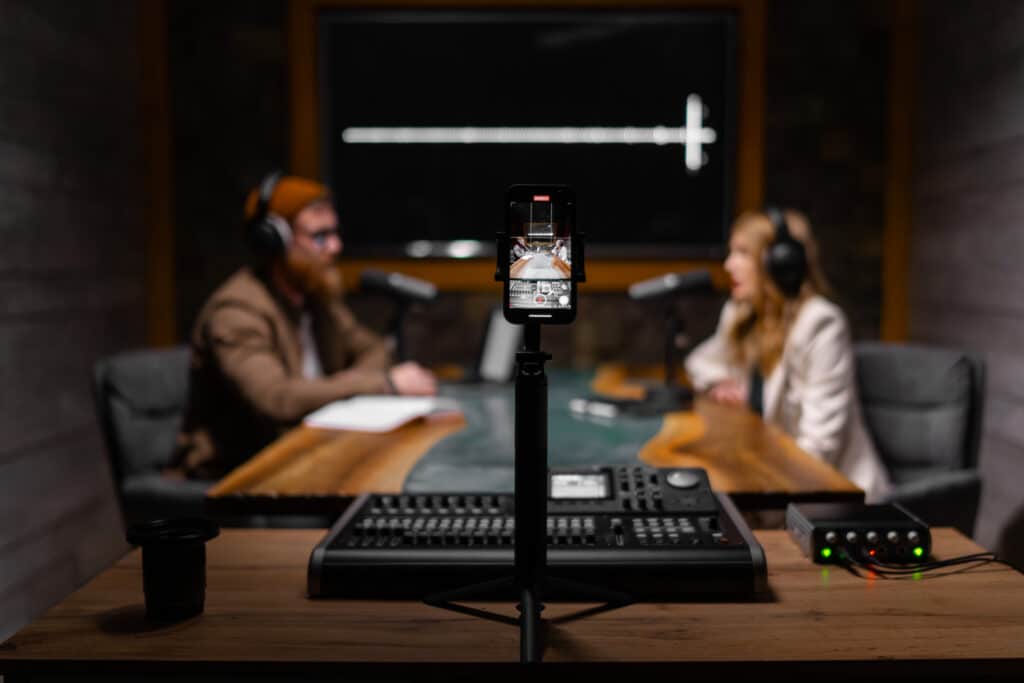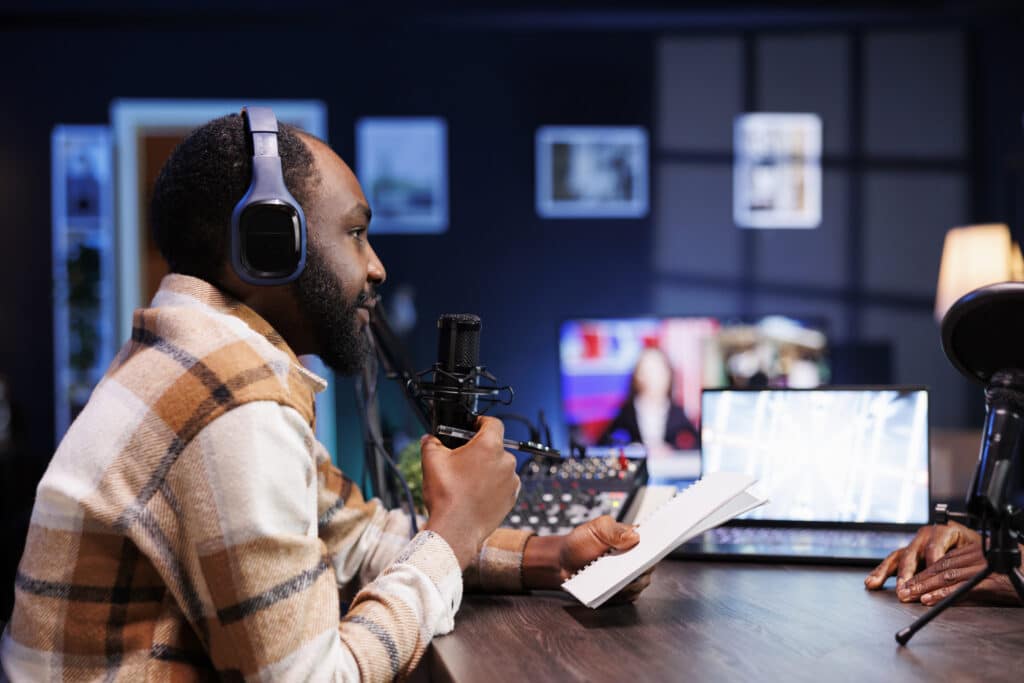The Importance of Professional Podcast Recordings & Production
05/02/2024
6 Reasons Why You Should Consider Professional Podcast Editing Services
Professional Podcast Services: How to Make Your Podcast Sound Professional
Podcasting has exploded in popularity but standing out takes more than just good ideas. In fact, a survey by The Podcast Host found that 67% of listeners say poor audio quality is the main reason they stop listening to a podcast. On the flip side, clean, professional sound keeps people engaged, builds trust, and helps your show grow.
Whether you’re just starting out or looking to elevate your production, here’s how to make your podcast sound professional and why investing in professional services can make all the difference.

Why Sound Quality Matters
A podcast should be enjoyable and immersive, but background noise, echoes, or uneven voices can quickly turn listeners off. Studies show that 56% of listeners are more likely to recommend a podcast with high production quality (Podcast Trends Report, 2023).
Good audio does more than make you sound clear:
- It reinforces credibility — your audience takes you more seriously.
- It improves retention — listeners stay longer when sound is easy on the ears.
- It boosts discoverability — polished podcasts attract sponsors, guests, and more word-of-mouth sharing.
In today’s competitive landscape, pristine audio isn’t optional. It’s the foundation of success.
Step 1: Start with Your Recording Environment
- Choose a quiet space, away from street noise and appliances.
- Avoid echoey rooms. Add rugs, curtains, or even blankets to absorb sound.
- Invest in a good microphone: even an affordable USB mic can outperform your laptop mic by a mile.
👉 Stat to note: A study by Edison Research found that over 74% of podcast listening happens on headphones, which makes flaws in recording environments even more noticeable.

Step 2: Use Proper Mic Technique
- Stay 6–8 inches from the mic.
- Speak across the mic (not directly into it) to avoid pops.
- Use a pop filter or windscreen to cut harsh “p” and “s” sounds.
Small improvements in technique can eliminate the majority of beginner mistakes.
Step 3: Edit for Clarity
Editing is where your podcast moves from raw recording to something listeners will actually enjoy. Focus on:
- Removing long pauses, filler words, and awkward silences.
- Cutting out background hums, clicks, or mic pops.
- Keeping conversation flowing with smooth pacing.
👉 Fact: According to Pacific Content, podcasts with polished editing have 22% higher listener retention compared to unedited recordings.
Step 4: Balance with Mixing
Mixing makes your podcast sound cohesive and professional:
- Match volume levels between hosts and guests.
- Blend background music so it complements, not competes.
- Use EQ and compression to smooth voices and remove harsh tones.
Bad mixing (like music that’s too loud or uneven speaker levels) frustrates listeners and makes them hit skip.
Step 5: Master for Consistency
Mastering is the final polish before publishing:
- Normalize volume so listeners don’t need to adjust constantly.
- Add subtle EQ adjustments for clarity.
- Export in the right file format (usually MP3 at 128–192 kbps).
👉 Pro insight: Consistent volume across episodes is one of the top factors listeners associate with professionalism (Buzzsprout, 2023).
Step 6: Know When to Go For Professional Podcast Services
DIY is a great start, but podcast production is time-consuming. According to PodNews, the average 60-minute episode takes 4–6 hours to edit and produce. That’s time you could be spending booking guests, researching, or promoting your show.
Professional podcast services can help with:
- Time efficiency — faster turnaround and consistent releases.
- Advanced storytelling — editing that improves pacing and flow.
- Stronger brand image — polished shows attract sponsors and collaborations.
- Accessibility — cleaner audio is easier for non-native speakers and those with hearing challenges.

Step 6: Know When to Go Professional
DIY is a great start, but podcast production is time-consuming. According to PodNews, the average 60-minute episode takes 4–6 hours to edit and produce. That’s time you could be spending booking guests, researching, or promoting your show.
Professional podcast services can help with:
- Time efficiency — faster turnaround and consistent releases.
- Advanced storytelling — editing that improves pacing and flow.
- Stronger brand image — polished shows attract sponsors and collaborations.
- Accessibility — cleaner audio is easier for non-native speakers and those with hearing challenges.
Using Background Music and Sound Effects the Right Way
Background music and sound effects can elevate your podcast, they set the tone, build atmosphere, and help transitions flow smoothly. But there are two big things to keep in mind:
🎵 Choose Music That Fits the Mood
- Use music to complement your content, not overpower it.
- Keep background tracks subtle — listeners should always hear the voices clearly.
- Limit music under dialogue to softer, instrumental tracks so lyrics don’t compete.
⚖️ Understand Licensing Rules
Not all music is free to use. Using copyrighted tracks without permission can result in takedowns, lost monetization, or even legal action. To stay safe:
- Use royalty-free music libraries (like Artlist, Epidemic Sound, or AudioJungle).
- Check Creative Commons licenses carefully — some require attribution.
- For commercial podcasts, always ensure the license covers commercial use.
- When in doubt, buy a license — it’s affordable insurance for your podcast.
🔊 Sound Effects
Sound effects can emphasize moments, transitions, or storytelling — but the same rules apply. Use effects from libraries you have rights to, and keep them subtle so they don’t feel gimmicky.
👉 Stat: A 2022 Spotify study found that listeners are 24% more likely to finish an episode that uses music and sound effects effectively — but poor mixing or distracting audio has the opposite effect.
You don’t have to do it all alone. Podcasting takes creativity, time, and energy, and the technical side can quickly become overwhelming. At Outcast Media, we can help you shape your recordings into professional, listener-ready episodes that reflect the quality of your ideas. Whether you’re looking for full editing support from start to finish or just a little extra polish to make your sound shine, we’ll work with you to create episodes that are clear, consistent, and engaging. With the production side handled, you can focus on what matters the most, sharing your story, connecting with your audience, and growing your podcast with confidence.
We prioritize prompt customer service and guarantee a response within 24 hours.
Ready to Collaborate?
"*" indicates required fields